
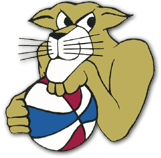
  |
Carolina Cougars2012 NBA/ABA Throwback Uniforms -
|
Back to "Remember the ABA" Main Page
Did you see a Carolina Cougars game? Or, did you have a favorite Cougars player? Contribute to this web page by
The Carolina Cougars were born in the spring of 1969, when the Southern Sports Corporation (owned by several North Carolina businessmen) agreed to buy the troubled Houston Mavericks franchise and move it to North Carolina. The feeling at the time was that since North Carolina did not yet have a huge metropolitan area in which to base a franchise, the team would divide its time between the somewhat populous cities of Greensboro, Charlotte, and Raleigh. Carolina became the first professional basketball team to use this "regional" concept, and for this franchise at least, it was somewhat successful. The Cougars cultivated a very strong following in Greensboro, a somewhat strong following in Charlotte, and a not-so-strong attendance record in Raleigh.
The 1969-70 and 1970-71 Cougars teams were mediocre but successful considering how little talent the team had inherited from Houston. The early Carolina teams tried to draw fans by signing players who had played their college ball in the state of North Carolina, like Bob Verga (All-America at Duke, 1967) Doug Moe (North Carolina), Gene Littles (NAIA All-American at High Point College), and Bill Bunting (North Carolina).
Before coming to the Cougars for the 1969-70 season, Verga had been an ABA journeyman, with stops in Dallas, Denver, New York, and Houston. With the Cougars, he put it all together and had an excellent season, averaging 27.5 ppg. Verga gained a berth on the ABA All-Star game squad and was elected to the ABA's First Team All-League team. Moe also had a nice season before his college fans, averaging 17.2 ppg in 80 games. For Littles, his first pro season was an unqualified success -- he shot 51% from the floor, averaged 12.5 ppg, and earned a second team All-Rookie berth. In their first season, the Cougars averaged a healthy 6,051 fans per game at home and made the playoffs, bowing out in four straight to eventual champion Indiana.
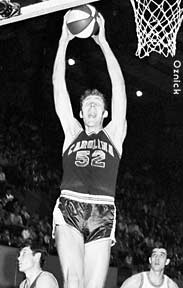 |
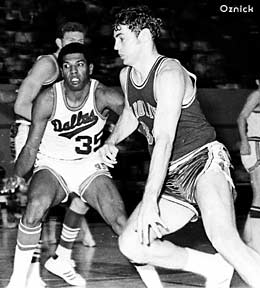 |
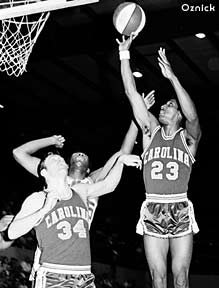 |
| The 1969-70 Carolina Cougars bore almost no resemblance to their immediate franchise predecessors, the 1968-69 Houston Mavericks. First, the Cougars had an immediate and loyal fan following at home (relegating Houston's notorious attendance problems to distant memory). Second, the Cougars quickly obtained some watchable, talented players.
For one, ABA veteran Bob Verga (right, #11) was an unstoppable scoring machine (27.5 ppg) throughout 1969-70. Both at home and on the road, Verga could be counted on to take a lot of shots and make a good percentage of them. Doug Moe (above center) complimented Verga by averaging 17.2 ppg. But scoring was secondary to Moe's primary mission with the Cougars -- to shut down each opponent's high scorer. Moe became a favorite with new Carolina fans due to his suffocating and relentless defense. Rookie Gene Littles (above right, #23) became an instant hit with Cougars fans as he earned all-rookie honors. Littles ended up staying with the Cougars from first year of existence (1969-70) through their last (1973-74). 7'1" Center Rich Niemann (above left, #52) had the best season of his career, averaging 11.3 ppg and 8.9 ppg. (Photos Copyright © John Oznick and used with permission) |
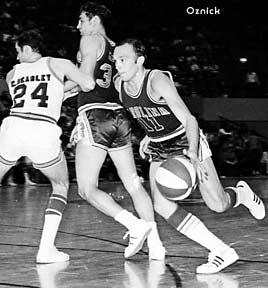 |
The first Cougars' coach was the ever-popular and colorful Bones McKinney. McKinney initially refused the job twice before Cougars President Jim Gardner finally convinced him to give it a try. According to the 1969-70 Carolina program, McKinney entertained ABA fans by "squirming in agony, leaping in ecstasy, gulping soft drinks by the case, yanking up his trademark red sox, yelling at (or for) somebody, and helping officials as best he could." He was a gate attraction all by himself.
The face of the franchise really changed once the team was bought by Tedd Munchak, who was willing to spend money. For the 1970-71 season, the Cougars lured the talented Joe Caldwell from the Atlanta Hawks of the NBA. Caldwell gave the Cougars some scoring punch, but didn't get them into the playoffs. One of the franchise's most "colorful" moments occurred on November 14, 1970, when the Cougars played the Indiana Pacers at Dorton Arena in Raleigh. The day before, a large cattle show had occupied the arena. While the cattle had vacated the premises before the start of the game, a large number of insects had not. A huge swarm of flies greeted the Cougars, the Pacers, and their fans. Many fans left at halftime, but the players and officials on the court had no such option.
For the 1971-72 season, the Cougars drafted and signed Jim McDaniels, a talented center from Western Kentucky. McDaniels provided still more offense and excitement (if not defense) for much of the season, before quitting and jumping to the Seattle Supersonics of the NBA. Once again, the Cougars failed to make the playoffs. However, the Cougars had reason to be optimistic because they had signed NBA All-Star Billy Cunningham away from the Philadelphia 76ers, and knew that he would play for the Cougars in the 1972-73 season.
|
|
|
|
| Carolina's aggressive young general manager Carl Scheer (left) bargained with some difficult personalities during his tenure. Joe Caldwell (middle) jumped to the Carolina from the NBA, but didn't seem to enjoy his years with the Cougars. Jim McDaniels (right) came to the team with high expectations, but he abandoned Carolina after playing only 58 games with the team. (ABA publicity photos courtesy of Jon Singer) |
The other significant break for this franchise occurred when general manager Carl Scheer hired recently-retired ABA players Larry Brown and Doug Moe to coach the team in 1972-73. With Cunningham and Caldwell, plus the speedy Mack Calvin at guard, Brown had some All-Star caliber players to work with. Ed Manning (father of current NBA star Danny Manning) Gene Littles, and Steve "Snapper" Jones also were there to provide still more veteran leadership. The Cougars also had some impressive young players like Dennis Wuycik, Tom Owens, Ted McClain and Steve Previs. During training camp in the Fall of 1972, Brown implemented a trapping defense plus the "passing-game" offense, and the new look Cougars took off from there.
The Cougars were 8-3 in the exhibition season, highlighted by a 5-1 record against NBA and including one-sided blowouts over the New York Knicks, the Boston Celtics, the Atlanta Hawks, the Buffalo Braves and the Kansas City-Omaha Kings. The Cougars jumped out quickly in the regular season as well, winning their first four games and eight of their first 11, and occupying a first-place standing that remained constant through the entire 1972-73 season (an ABA first). Attendance increased 40% over the year before: 340,000 fans, a club record, witnessed Cougar action in North Carolina. This figure included 14,126 rabid Cougars fans who turned out on December 30, 1972 in Greensboro to see the Carolina play its arch-rival, the Kentucky Colonels. After three quarters of nip-and-tuck ball, the Cougars ousted Kentucky 104-91. The victory was Carolina's sixth straight, and it allowed the Cougars to keep first place going into 1973.
Carolina ended up winning 57 games in 1972-73, the most in the ABA that season. Billy Cunningham (overall league MVP), Larry Brown (ABA Coach of the Year), and even Carl Scheer (ABA Executive of the Year) garnered impressive individual honors. Three Cougars -- Cunningham, Caldwell and Calvin (the "Three C's") -- played in the 6th Annual ABA All-Star Game, played on February 6, 1973 in Salt Lake City.
With home court advantage throughout the 1973 ABA Playoffs, expectations for the Cougars were high. In the first round, the Cougars outmanned and overwhelmed New York, eliminating the Nets in four straight games. In the second round, the Cougars faced Dan Issel, Artis Gilmore and the Kentucky Colonels. This hard-fought series went the full seven games. After taking a 3-2 series lead, poor shooting prevented Carolina from closing out the series. The Colonels won Game 6 at Louisville in a 119-100 blowout. Game 7 was played at the Charlotte Coliseum, and an ABA Finals berth against the Indiana Pacers awaited the winner. The Colonels broke open a close and tense game in the second half, and coasted to a 107-96 victory before 10,231 disappointed Cougars fans.
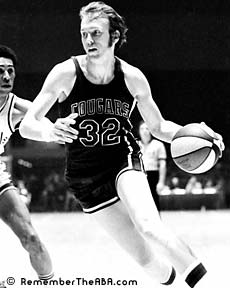 |
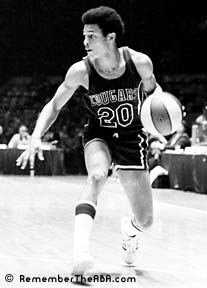 |
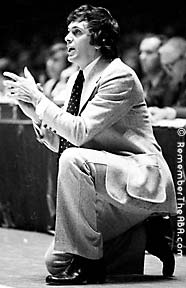 |
| In his first year as a professional basketball coach, 32-year old Larry Brown (above right) guided the 1972-73 Cougars to 57 victories and first place in the ABA's Eastern Division. The team was one of the most powerful in ABA history. Carolina shattered over 30 existing club records, including most wins in a row (11), most consecutive home (15) and road (6) victories, most road wins in a season, and biggest margin of victory (126-78 against the Nets on October 14, 1972), and of course their best all-time record (57-27).
While Carolina's newfound success depended on an overall team concept, the three players pictured here provided most of the team's firepower. Newcomer Billy Cunningham (above left, #32) sliced through ABA defenses and dominated the boards, averaging 24.1 ppg and 12.0 rpg. That performance was enough to gain ABA MVP honors above players like Julius Erving and George McGinnis. "Pogo Joe" Caldwell (right, #27) thrived playing pressure defense, wowing Carolina fans with multiple steals and breakaway dunks. With Caldwell driving to the hoop from the right and Cunningham driving to the hoop from the left, Carolina's offense was feared around the ABA. But the true sparkplug behind the Cougars' offense was feisty 6'0" guard Mack Calvin. Picked up by Carolina in the dispersal draft of former Floridians players, Calvin displayed his usual lightning-quick drives, floating layups and no-look passes. Cunningham, Caldwell and Calvin all played in the 1973 ABA All-Star Game. |
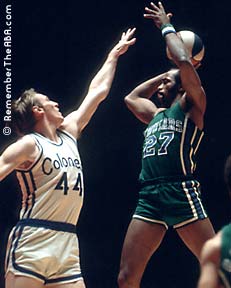 |
Carolina fans thought that the team could make the ABA Finals the next season, 1973-74. But due to injuries and team discord, Larry Brown's second season with the team was a disappointment. League MVP Cunningham played in only 32 games during the course of the season, due to kidney blockage that required serious surgery in December. Dennis Wuycik, a good shooter, suffered a severe ankle sprain shortly after Cunningham's surgery, and didn't resume action for two months. Center Mike Lewis, already out for a season and a half due to a torn Achilles tendon, was only activated in early March. At one point, coach Brown was not able to scrimmage his team for more than a month because of a lack of players. Without Cunningham's leadership, other Carolina players squabbled and struggled to find a team leader.
A bright spot on the 1973-74 roster was theft-king Ted "Hound-Dog" McClain. During his college years, McClain's teammates gave him the nickname "Hound-Dog" because he "hounded" opponents on defense. On December 26, 1973, in a game against the Nets in Raleigh, the feisty guard set an ABA record with 12 steals. On March 2, 1974 against the Pacers, McClain registered his 222nd steal of the season, leaping over teammate Cunningham's year-old record.
Despite all their injuries and discord, the team finished 10 games above .500, at 47-37. But, the Cougars never gained enough chemistry (or consistency) to leapfrog the Nets or the Colonels in the Eastern Division standings. In the first round of the 1974 ABA Playoffs, the Cougars faced the second-place Colonels and lost the series in four straight games.
During the Cougars' 1973-74 season, there were persistent rumors that the team would be sold and moved away from North Carolina -- despite strong attendance and fan support. Those rumors turned out to be true, as Tedd Munchak sold the team shortly after the season to a group of New York businessmen. The Cougars moved to St. Louis, where they became the Spirits of St. Louis. Few of the Cougars players were kept by the Spirits. Larry Brown and Doug Moe took their act to Denver and revitalized that franchise.
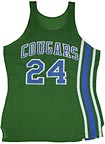 Cougars 1971-73 Road Uniform |
Cougars 1973-74 Home Warmup |
1969-70 Season
Eastern Division Semifinals vs. Indiana Pacers (59-25)
Pacers won series, 4-0
Record: 34-50, Sixth Place in Eastern Division
Missed Playoffs
Record: 35-49, Fifth Place in Eastern Division
Missed Playoffs
Record: 57-27, First Place in Eastern Division
1973 Playoff Results:Eastern Division Semifinals vs. New York Nets (30-54)
Cougars won series, 4-1
Eastern Division Finals vs. Kentucky Colonels (56-28)
Colonels won series, 4-3
Record: 47-37, Third Place in Eastern Division
1974 Playoff ResultsEastern Division Semifinals vs. Kentucky Colonels (53-31)
Colonels won series, 4-0
Franchise moved to St. Louis and became the Spirits of St. Louis